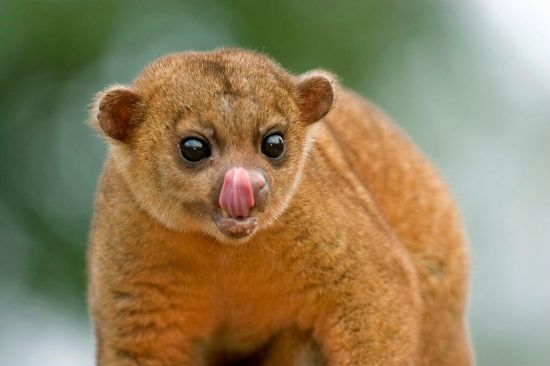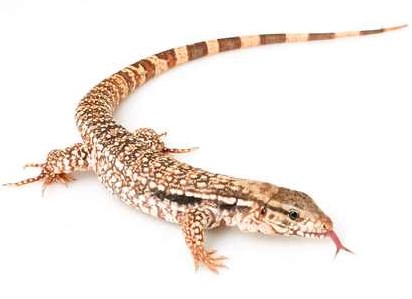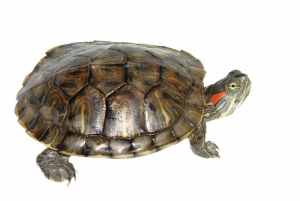Exotic pets in Florida fit into two categories: the known and the all-too-well-known. Sometimes there’s the unknown.
The nonnative animal invasion was going strong in 2006 when the Exotic Pet Amnesty Program was formed. Workers for the state Fish and Wildlife Conservation Commission roll around the state like a traveling zoo, absorbing an eye-popping menagerie of ecological evil-doers. In nine years more than 2,100 animals from about 150 species and sub-species were turned in to the FWC, no fines, no questions asked.
 "We’re also helping to find them good homes," the FWC's Carlie Segelson said.
"We’re also helping to find them good homes," the FWC's Carlie Segelson said.
More than 500 nonnative fish and wildlife are Florida residents. From 1863 through 2010, 137 invasive amphibian and reptile species were introduced, according to a University of Florida study, and 25 percent were linked to one animal importer. With 43 alien lizards on the list, native lizards are outnumbered nearly 3 to 1.
Red-eared sliders are all-too-well-known in Florida, cut loose in the wild by turtle buffs. FWC statistics show 327 of the terrapins have been collected through the EPAP. That's 20 percent of the pets voluntarily placed under the state's house arrest.
“They were just really popular in the pet industry,” Segelson said. “They’re a pretty basic pet … probably a step up from a bull snake.”
The next Exotic Pet Amnesty Day isn't scheduled until April, but Red-eared sliders will surely be there.
Part of the name is for the turtle's ability to slide into water quickly and skedaddle out of danger. And they had better scram with the likes of the Tegu lizard and Burmese python, a couple of ecological brutes on every conservation group's most wanted list. None were surrendered at an Exotic Pet Amnesty Day Nov. 17 in Naples.
“One [amnesty] I remember most was a Burmese python that was turned in in Naples, not this Amnesty Day, but last year,” Segelson said. “You know, it was a very large snake.
Red-eared sliders grow as long as 12 inches, disrupt the native food chain, and owe their popularity in part to the Ninja Turtles franchise, according to legend and also the U.S. Geological Survey. There are signs they are producing young with another turtle non-grata, Yellow-bellied sliders, never a good thing for the animal kingdom.

» “We’ve never received anything so crazy that we couldn’t identify them eventually.”
Only five Tegus have been surrendered to the Exotic Pet Amnesty Program since 2006. One came via the exotic species hotline: 888-Ive-Got-1 (483-4681). But 99 Green Iguanas and 76 Burmese pythons were taken out of circulation in nine years.
Green iguanas cause economic damage, ruining landscaping and eating crops. The U.S. Fish and Wildlife Service says invasive wildlife and plants cost the U.S. $120 billion annually in direct and indirect damage.
The Naples count was 28 exotics, not including 18 parakeets from one owner. The inventory included two Red-tailed boas, one Boa constrictor, one Ghost-corn snake, three Ball pythons, and two Sulcatas, or African-spurred tortoise -- the third largest tortoise in the world and biggest in Africa, often tipping 200 pounds.
Over the years, 49 sulcatas went to new homes through the FWC's program.
“Sometimes people are just suddenly struck by how difficult it is to care for some of these animals,” Segelson said. “And they’re just happy to know they’re going to good homes.”
The new homes are found on an FWC list of 530 pre-approved animal caretakers, both individuals and organizations, Segelson said.
“We need to get those people lined up ahead of time and ideally get adopters who are in the area of the amnesty event,” said Segelson, a three-year veteran of the program.
 The FWC partners with the FWS and gets help from regional wildlife groups for Exotic Pet Amnesty Days. The next event is scheduled in Melbourne in April.
The FWC partners with the FWS and gets help from regional wildlife groups for Exotic Pet Amnesty Days. The next event is scheduled in Melbourne in April.
“It’s a very interesting day,” Segelson said. “It’s interesting to see because you don’t know what’s going to happen or what’s going to show up.”
Like a Chinchilla, which, go figure, was collected this year in Palm Beach, along with a Giant ameiva lizard; a Madagascar Giant Day gecko; and a Kinkajou. Two other pets were initially listed as “unknown.”
“Sometimes [wildlife officials] may have a difficult time on the scene making an immediate identification but they’re identified later,” Segelson said. “We’ve never received anything so crazy that we couldn’t identify them eventually.”
Still, one native habitat’s threat is frequently someone’s pet. But releasing an exotic into the wild is against the law, though no one has ever been punished under that law.
“The program has been a positive outreach to the public,” Segelson said. “We're keeping animals from potentially being released into the wild."
Outside
Bitcoin mining emissions in China will hit 130 million tonnes by 2024 https://t.co/w6He7so8N2 pic.twitter.com/qYUDtBdeRK
— New Scientist (@newscientist) April 9, 2021
The Gunk Report
For the Blue-Green Algal Bloom Weekly Update from the Florida Department of Environmental Protection, tap here. For DEP's Algal Bloom Sampling Map, tap here.
What, me worry?
» "PLAYING WITH SHARKS," which recently premiered at the Sundance Film Festival, documents diving legend Valerie Taylor.